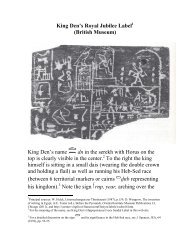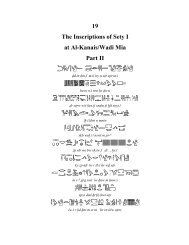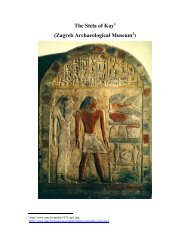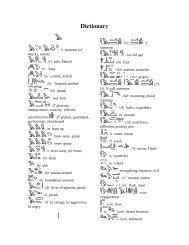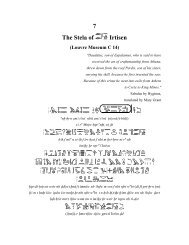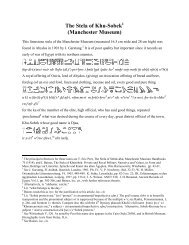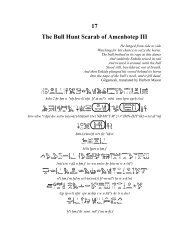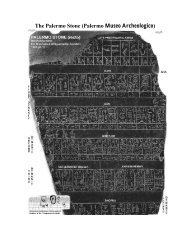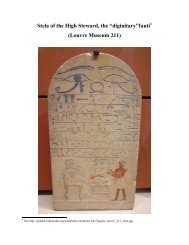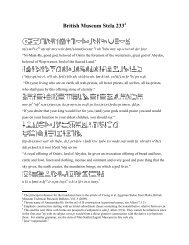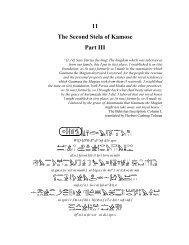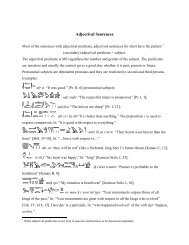The Stela of Djehuti-nakht - Middle Egyptian Grammar
The Stela of Djehuti-nakht - Middle Egyptian Grammar
The Stela of Djehuti-nakht - Middle Egyptian Grammar
You also want an ePaper? Increase the reach of your titles
YUMPU automatically turns print PDFs into web optimized ePapers that Google loves.
<strong>The</strong> <strong>Stela</strong> <strong>of</strong> <strong>Djehuti</strong>-<strong>nakht</strong> 1<br />
(Museum <strong>of</strong> Fine Arts, Budapest)<br />
1 Joint work with Michael McClain. During his visit to Hungary in November 2011, the author is grateful for Dr.<br />
Éva Liptay, head curator <strong>of</strong> the <strong>Egyptian</strong> Collection <strong>of</strong> the Museum <strong>of</strong> Fine Arts, Budapest, for introducing and<br />
providing guidance for the museum’s artifacts not on display, and providing high resolution images.
Htp-di-(n)swt wsir xnt(i)-imntiw, Htp-di-(n)swt inpw tp Dw.f imi wt, 2 nb tA Dsr [di.sn]<br />
prt xrw t fn[x]w 3 m AbDw<br />
A royal <strong>of</strong>fering <strong>of</strong> Osiris, foremost <strong>of</strong> Westerners, and a royal <strong>of</strong>fering <strong>of</strong> Anubis who is on the<br />
top <strong>of</strong> his mountain and in the place <strong>of</strong> embalming, lord <strong>of</strong> the Sacred Land, (giving) an<br />
invocation <strong>of</strong>fering and bread and food <strong>of</strong>ferings from/in Abydos:<br />
4<br />
xA t, xA H(n)qt, xA kA, xA (i)rp, xA Tp(t), 5 xA zt, xA s, 6 xA mnxt, 7 xA H(A)b, 8 hA Xkr 9<br />
1000 loaves <strong>of</strong> bread, 1000 (jugs) <strong>of</strong> beer, 1000 cattle, 1000 (jars) <strong>of</strong> wine, 1000 (cups) <strong>of</strong><br />
(intoxicating) drink, 1000 ducks, 1000 clothes, 1000 linen, 1000 festivals, and 1000 ornaments.<br />
<strong>The</strong> largest standing male figure in the center is the owner <strong>of</strong> the stela. <strong>The</strong> inscription on the top<br />
to the right is: Sps (n)swt (i)r(i)-p(at) 10 mnw 11 “king’s gentleman, nobleman <strong>of</strong><br />
Akhmin.” Facing this is the following: DHwti-nxt, mry.f, Xr(i)-H(A)b 12 Smsw<br />
“<strong>Djehuti</strong>-<strong>nakht</strong>, his 13 beloved, senior lector priest.” Directly in front <strong>of</strong> his face <strong>Djehuti</strong>-<strong>nakht</strong><br />
has yet another title: (i)m(i)-r wpwti 14 “overseer <strong>of</strong> the (royal) commissioners.”<br />
2 Reconstruction; see e.g. line 1 <strong>of</strong> the stela <strong>of</strong> Merer in Cracow Museum.<br />
3 Probably a defective writing <strong>of</strong> fnxw “food <strong>of</strong>ferings.”<br />
4 A line <strong>of</strong> four signs Apd “bird.”<br />
5 See Wb. V, 366.<br />
6 For .<br />
7<br />
Written as with two additional strands to the usual ; see Gardiner Sign-list S27, p. 507, and also Urk. IV<br />
175, 3. <strong>The</strong> complements are clearly visible.<br />
8 Note that the sign is an occasional substitute for . In addition, in the 11 th and 12 th Dynasties, the writing<br />
H(A)bw “festivals” is attested, cf. Gardiner, Sign-list X4, p. 532.<br />
9 Conjectural; the signs k and r are visible.<br />
10 Conjectural; the sign p is not underneath r, but the same practice appears in line 4 in the spelling <strong>of</strong> (i)rp.<br />
11 <strong>The</strong> 9 th nome <strong>of</strong> Upper Egypt. For the spelling, see Wb. II, 72.<br />
12<br />
<strong>The</strong> bottom sign looks like a t.<br />
13<br />
I.e. the king’s.<br />
14<br />
Attested Old and <strong>Middle</strong> Kingdom title; see Wb. I, 303.
To the left <strong>of</strong> <strong>Djehuti</strong>-<strong>nakht</strong>, the standing woman (with her left arm resting on his shoulder) has<br />
the inscription: Hwt-Hrw Hm(t)-nTr, rpi 15 “Hathor priestess, Repi.” To his right, a<br />
small standing figure is <strong>of</strong>fering a joint <strong>of</strong> meat to him. <strong>The</strong> inscription there reads<br />
wnp 16 imAx “Wenep, justified.”<br />
15 <strong>The</strong> name rp “Rep” is attested; see Ranke, PN. 222.<br />
16 <strong>The</strong> name wn and its many variations are attested; see Ranke, PN pp.78-79.



